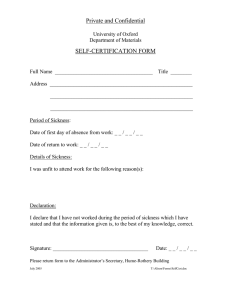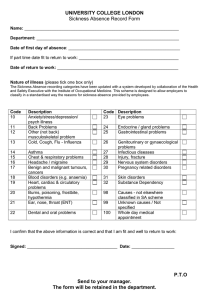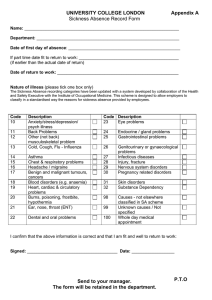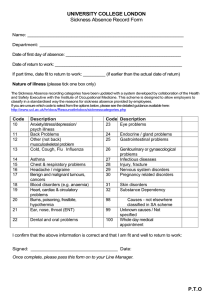ITEM No 6 REPORT OF THE STRATEGIC DIRECTOR OF CUSTOMER AND
advertisement
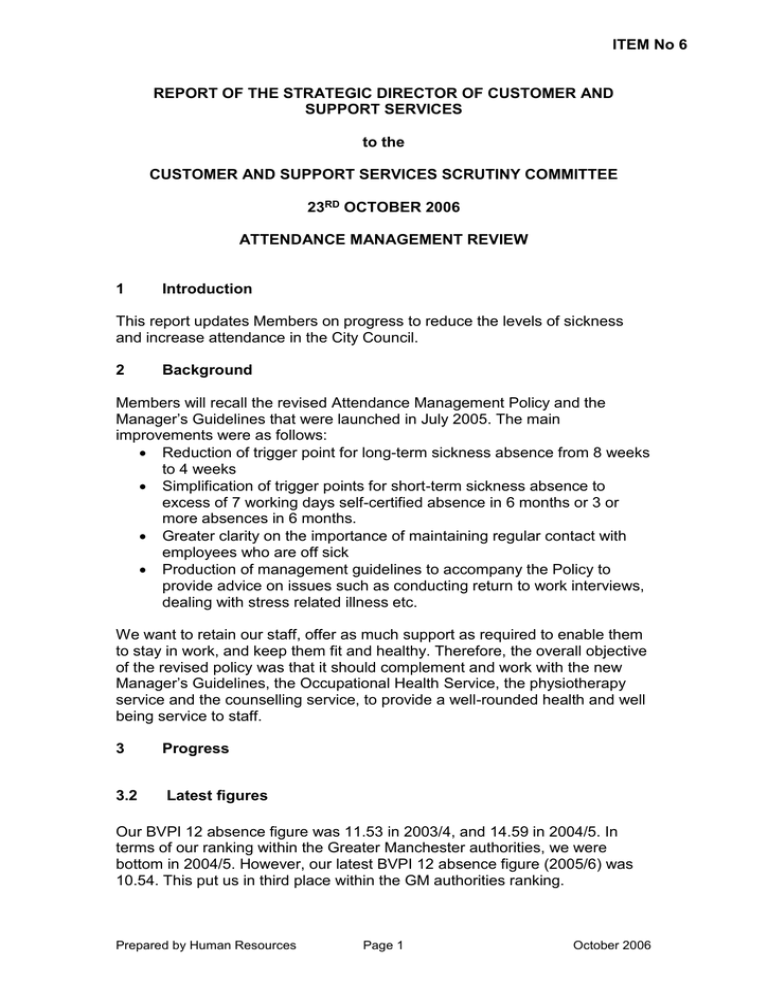
ITEM No 6 REPORT OF THE STRATEGIC DIRECTOR OF CUSTOMER AND SUPPORT SERVICES to the CUSTOMER AND SUPPORT SERVICES SCRUTINY COMMITTEE 23RD OCTOBER 2006 ATTENDANCE MANAGEMENT REVIEW 1 Introduction This report updates Members on progress to reduce the levels of sickness and increase attendance in the City Council. 2 Background Members will recall the revised Attendance Management Policy and the Manager’s Guidelines that were launched in July 2005. The main improvements were as follows: Reduction of trigger point for long-term sickness absence from 8 weeks to 4 weeks Simplification of trigger points for short-term sickness absence to excess of 7 working days self-certified absence in 6 months or 3 or more absences in 6 months. Greater clarity on the importance of maintaining regular contact with employees who are off sick Production of management guidelines to accompany the Policy to provide advice on issues such as conducting return to work interviews, dealing with stress related illness etc. We want to retain our staff, offer as much support as required to enable them to stay in work, and keep them fit and healthy. Therefore, the overall objective of the revised policy was that it should complement and work with the new Manager’s Guidelines, the Occupational Health Service, the physiotherapy service and the counselling service, to provide a well-rounded health and well being service to staff. 3 Progress 3.2 Latest figures Our BVPI 12 absence figure was 11.53 in 2003/4, and 14.59 in 2004/5. In terms of our ranking within the Greater Manchester authorities, we were bottom in 2004/5. However, our latest BVPI 12 absence figure (2005/6) was 10.54. This put us in third place within the GM authorities ranking. Prepared by Human Resources Page 1 October 2006 The latest sickness absence figures (Appendix 1 - October 2005 to September 2006) show an increase in average days lost since the previous quarters figures from 9.6 to 10.5 average days. (Please note that these relate to headcount figures not FTE figures and as such will not relate directly to the PI definition) The PI figures for quarter 2 also show an increase from 10.50 to 10.52 average days lost. 3.3 Improvements to management information Since the restructuring of the Systems and Information team, and the introduction of a new post of Management Information Officer, significant improvements have been made to the types of information which we can provide to managers. The most significant development to take place was the introduction of attendance management workshops for each directorate. These were held at the Broadwalk in July and we had excellent feedback from attendees. The format of the workshops was to present the absence figures by directorate and by area so that areas of concern could be noted and then discussed. In addition, some demographic data was presented that highlighted areas of interest by age/gender/pay scale etc. Representatives from HR and the Occupational Health and Safety unit (OH) were also in attendance, to help with the discussions. A copy of the presentation used for the Customer and Support Services workshop is attached at Appendix 6. The workshops really highlighted that there was a lack of understanding of the figures by each area, and instilled into those managers attending the importance of understanding the figures so as to be able to challenge and manage these. In particular, the Housing and Planning directorate have embraced the concept of the workshops and meetings, and have been very keen to participate and work with us on identifying areas to improve upon. Quarterly meetings are now taking place with each directorate, along with representatives from OH and HR. The purpose of these meetings has been to highlight particular areas of interest for managers, and then to work with the OH and HR teams to identify areas of concern and potential solutions. The first round of these sessions has already proved to be beneficial to managers and we are finding that the utilising the knowledge of OH and HR at the same meeting is proving invaluable. The most common reasons for absence are highlighted at these meetings, and managers work with the OH and HR teams to understand and work through ways to address these. We have also set up a new HR intranet page that covers general workforce statistics, including absence data, and these are updated on a quarterly basis so that the latest data is always available. The link for these is http://intranet.salford.gov.uk/customer/humanresources/workforcestatistics.htm. Prepared by Human Resources Page 2 October 2006 The online sickness absence recording form has seen a continued roll out this quarter. To date the feedback has been very positive not only from those using the facility but also from Salford City Council’s Audit Team (see 3.4). Current functionality now includes: Timely entry of sickness absence onto SAP Management Information, namely the ability to view the last 6 months absence for an employee Automated emails to managers when an absence is entered with details of the absence and the last 6 months absence for that employee. Downloadable ‘Return to Work Form’ Automated emails to payroll where an absence is due to an accident so that potential SSP payments can be retrieved from any successful claim. Links to the Attendance Management Policy (AMP) AMP trigger reminders appear on screen Planned Improvements Reasons matrix to be added to improve consistency of reasons for absence reporting Links to Occupational Health Pages to provide managers with greater details of the service available from them and also information on illnesses and symptoms. Prevention of Pending Reason being an option for records that need closing Inclusion of the ‘Stress Pack’ so that it can be downloaded. 3.4 Audit compliance project In June of this year, we requested that audit undertake a review of the actual process in each directorate with regards to management of return to work interviews, sickness certificates etc, to check that managers were all complying with the policy. Many improvements have been put in place to assist managers in tackling absence, and in supplying better management information, but it was felt that audit should concentrate on actual compliance. The results of this project are still in a draft report, and members can expect to see the final version later this year. Initial results seem to show that there is inconsistency within the authority, with areas of good practice taking place, and other areas of very poor compliance with the policy. Enforcing use of the online form, senior managers disseminating the management information provided and extra training for managers have been highlighted as potential areas of improvement. Prepared by Human Resources Page 3 October 2006 3.5 Communications campaign HR have commissioned an employee communications campaign to highlight the effects that absence has on the authority. This campaign is due to be launched in December 2006 and will consist of a number of different approaches including posters, email alerts etc based on a theme of ‘we don’t work without you’. 3.6 Culture of Health and Well-being A comprehensive review of the Occupational Health service has been completed and arrangements are ongoing to implement changes to the service to focus on driving down sickness absence and more preventative work. The move to a nurse led service will free up the Occupational Health Physicians time to concentrate on case conferences, manager scripts and procedures to influence staff attendance and recovery from ill health. Changes to the OHSU structure have been implemented with the recruitment of a new post of Principal Occupational Health Nurse/Team Leader and the out stationing of Safety Officers into the directorates to deliver a better customer focused service. The unit will continue to work with the PCT to deliver a flu vaccination programme for staff for the third year running. Staff attending the vaccination service have increased to around 1200 in 2005. With access to more accurate data on the reasons for absence we have identified interventions to address the main causes of absence. In addition, the new Management guidelines state immediate referral to OH for cases of stress, anxiety and depression. In consultation with our AGMA partners OH have commissioned work on a trauma policy to deal with significant incidents at work. Stress at work is the largest single cause of absence from work in all AGMA councils. Figures only relate to sickness absence where stress, anxiety and/or depression is the diagnosed cause on the medical certificate. In practice many other stomach, migraine etc causes may be stress related. Also a significant number of medical certificates have no legible diagnosis so many of these may be stress related also The stress counselling service has been operating for 5 years and has grown in use year on year with 710 appointments in the past year. We have responded to the demand for counselling by increasing the service from 3 days per week to 4 days per week. OH have placed a stress policy guide document on the intranet site for guidance on managing stress at work. This incorporates the HSE stress management standards. OH are developing a stress risk assessment tool to provide further guidance for directorates, and a stress pack has been developed for employees. Prepared by Human Resources Page 4 October 2006 3.7 Flexible working and benefits The City Council supports the principal that employees should enjoy a worklife balance and acknowledges that all individuals at all stages of their career work best when they are able to achieve an appropriate balance between work and all other aspects of their lives. In recognition of the City Council's commitment to ensuring that employees can achieve this balance, it is our intention to promote working practices that benefit both the organisation and all employees. In this respect we already have in place a comprehensive package of policies that support the work-life balance, including the Flexitime Scheme, Job Share, Voluntary Reduced Working Time, and elements of the special leave provisions. By accommodating requests for flexible working wherever possible, existing employees may have the opportunity to vary normal contractual hours to suit work and domestic circumstances. In addition to the above policies and arrangements, the City Council has a comprehensive package of leave provision for numerous purposes in accordance with both nationally and locally agreed conditions of service. 3.8 Best Absence Management Strategy Award We are very pleased to be able to announce that Salford have been shortlisted for the above prestigious award, run by Pay Magazine. The awards ceremony takes place in London on 14th November 2006. 4 Conclusion The improvements made as a result of this review provide managers with a robust framework to enable sickness absence levels to be reduced. Whilst it is essential to have such a framework in place, there is no doubt that those with people management responsibilities must take an active approach to caring for the health and wellbeing of their staff and using all of the options open to them in reducing sickness absence levels. HR are still constantly scanning to ensure that the approach adopted in our policies continues to reflect best practice. All the evidence shows that early and consistent interventions by line managers have the best impact on increasing attendance Prepared by Human Resources Page 5 October 2006 Appendices 1. Latest SAP headcount figures - October 2005 to September 2006 2. Latest PI figures – comparison of quarter 2 figures 3. Previous SAP headcount figures for comparison – July 2005 to June 2006 4. Previous PI figures for comparison 5. Latest PI benchmark information from AGMA authorities 6. Presentation to C&SS team for Sickness Absence Workshop. 7. Calculation for percentage absence – although members have raised concerns over the use of 260 days as the calculation for absence, this is the definition required for the calculation of the BVPI figures. 8. Generation of automatic flags when staff hit trigger points - consistent use of the online absence form will solve this problem, as managers can be made instantly aware of the sickness history of the employee concerned, and the trigger points are listed on the screen for them. Prepared by Human Resources Page 6 October 2006
